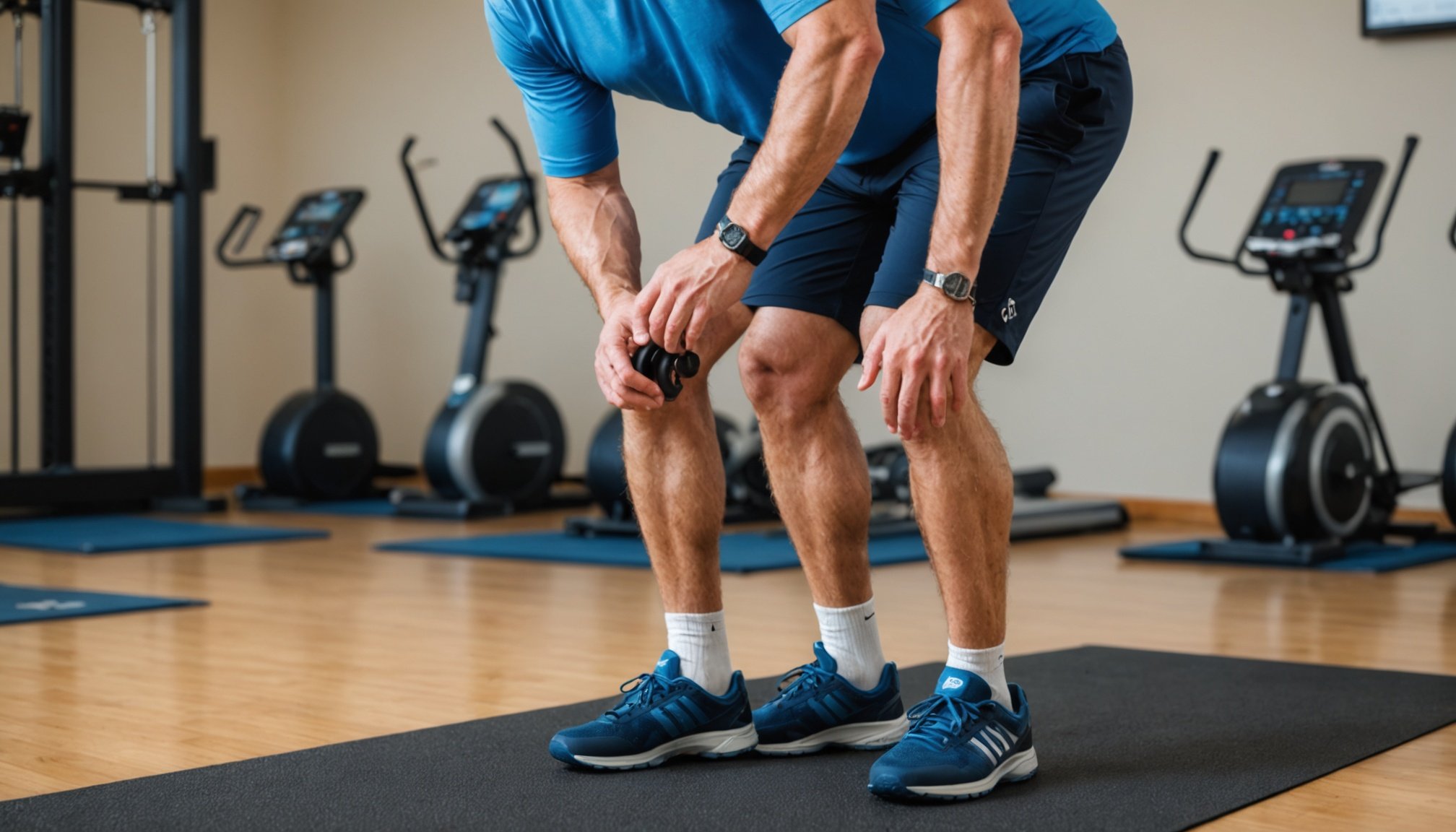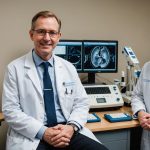Unlocking Recovery: The Impact of Continuous Passive Motion on Knee Replacement Rehabilitation
Understanding Continuous Passive Motion (CPM)
Continuous Passive Motion (CPM) machines have become a staple in the rehabilitation process for patients undergoing knee replacement surgery. But what exactly is CPM, and how does it work?
A CPM machine is a device designed to slowly and gently move a patient’s joint while they are in bed or resting. This motion is continuous and passive, meaning the patient does not have to exert any effort to move the joint. The primary goal of using a CPM machine is to increase the range of motion (ROM) of the affected joint, prevent scar tissue formation, and reduce pain and stiffness.
Also read : Exploring the Effects of Intermittent Hypoxic Training on Performance in Athletes with Asthma
Benefits of CPM in Knee Replacement Rehabilitation
The use of CPM machines in knee replacement rehabilitation offers several significant benefits.
Increased Range of Motion (ROM)
One of the most critical advantages of CPM is its ability to increase the ROM of the knee joint. After a total knee replacement, patients often experience stiffness and reduced mobility. A CPM machine helps by flexing the knee joint at regular intervals, gradually increasing the degree of flexion over time. This prevents scar tissue from forming and maintains or improves the joint’s mobility.
Also to discover : Exploring Innovative Minimally Invasive Methods for Aortic Aneurysm Repair: The Latest Techniques Unveiled
Muscle Strengthening
CPM machines also play a role in strengthening the muscles, tendons, and ligaments around the knee joint. By gently exercising these tissues, the machine helps prevent muscle atrophy and promotes faster recovery. This is particularly important as it supports the overall stability and function of the knee.
Pain Reduction
Using a CPM machine can significantly reduce pain and swelling in the knee. By elevating the leg and promoting blood flow, the machine helps in decreasing swelling, which in turn reduces pain. This makes the recovery process more comfortable for patients.
Prevention of Blood Clots
Another crucial benefit of CPM is its role in preventing blood clots. Patients undergoing knee replacement surgery are at a high risk of developing deep vein thrombosis (DVT) in the days and weeks following the surgery. The gentle motion provided by the CPM machine helps improve circulation, reducing the risk of blood clots.
How to Use a CPM Machine Safely
While CPM machines are highly beneficial, it is essential to use them correctly to avoid any complications.
Setting Up the Machine
Your healthcare provider will show you how to set up the CPM machine. This includes placing the machine against a stable object to prevent it from moving and securing the cord to avoid tripping hazards.
Adjusting the Settings
The machine’s settings, such as the degree of flexion, speed, and duration, need to be adjusted according to the patient’s needs. For example, for knee replacement patients, the machine might be set to flex the knee for up to 2 hours at a time, 3 to 4 times a day.
Safety Precautions
- Ensure the machine is securely attached to the patient’s leg or arm to prevent any movement.
- Remove any immobilizers before using the CPM machine, as advised by your healthcare provider.
- Monitor for any signs of complications such as increased pain, swelling, or fever, and stop using the machine immediately if any of these symptoms occur.
Clinical Evidence Supporting CPM
Numerous clinical studies and systematic reviews have evaluated the efficacy of CPM in knee replacement rehabilitation.
Systematic Review and Meta-Analysis
A systematic review of comparative studies on the utility of CPM after anterior cruciate ligament (ACL) reconstruction and other knee surgeries found that CPM facilitates faster and more efficient recovery by reducing joint stiffness and improving ROM. This evidence supports the use of CPM in various orthopedic surgeries, including knee arthroplasty.
Randomized Controlled Trials
Randomized controlled trials have also shown that CPM can significantly improve knee flexion and reduce the need for further surgical interventions. For instance, a study comparing patients who used CPM with those who did not found that the CPM group had better ROM and less pain post-operatively.
Practical Insights and Actionable Advice
Here are some practical tips and advice for patients using CPM machines during their rehabilitation:
Compliance and Monitoring
- Strictly follow the usage protocol provided by your healthcare provider to ensure maximum benefit and minimize the risk of overuse.
- Regularly monitor your progress and report any changes or concerns to your doctor.
Combining with Other Treatments
- CPM should be used in conjunction with other rehabilitation treatments such as physical therapy and exercise. This holistic approach can enhance recovery outcomes significantly.
Patient Experience
- “Using the CPM machine after my knee replacement surgery was a game-changer. It helped me regain my range of motion quickly and reduced my pain significantly,” says Jane, a patient who underwent total knee arthroplasty.
Comparison of Rehabilitation Methods
Here is a comparison of different rehabilitation methods often used post-knee replacement surgery:
| Rehabilitation Method | Description | Benefits | Drawbacks |
|---|---|---|---|
| Continuous Passive Motion (CPM) | A machine that moves the joint passively to increase ROM and reduce stiffness. | Increases ROM, reduces pain and stiffness, prevents blood clots. | Requires strict compliance, may be uncomfortable for some patients. |
| Physical Therapy | Active exercises and stretches guided by a physical therapist. | Strengthens muscles, improves balance and coordination, enhances overall function. | Requires active participation, may be painful initially. |
| Manipulation Under Anesthesia | A procedure where the joint is manipulated under anesthesia to improve ROM. | Quick improvement in ROM, useful for severe stiffness. | Invasive, carries risks associated with anesthesia. |
| Exercise and Weight Bearing | Patients perform specific exercises and bear weight on the affected leg. | Strengthens muscles, improves bone density, enhances functional recovery. | May be painful, requires careful monitoring to avoid overloading the joint. |
Post-Operative Care and Long-Term Outcomes
Post-operative care is crucial for the successful recovery of patients undergoing knee replacement surgery.
Immediate Post-Surgery Care
- Patients typically start using a CPM machine within the first few days after surgery.
- They are also advised to follow a strict regimen of physical therapy and exercises to complement the CPM treatment.
Long-Term Outcomes
- Studies have shown that patients who use CPM machines as part of their rehabilitation have better long-term outcomes in terms of ROM, pain reduction, and overall functional recovery.
- A systematic review found that CPM use can reduce the need for revision surgeries and improve patient satisfaction in the long term.
Continuous Passive Motion machines are a valuable tool in the rehabilitation process following knee replacement surgery. By increasing the range of motion, reducing pain and stiffness, and preventing blood clots, CPM machines can significantly enhance the recovery experience for patients.
As Dr. Smith, an orthopedic surgeon, notes, “CPM machines are an integral part of our rehabilitation protocol. They help our patients recover faster and more effectively, which is crucial for their overall well-being and return to normal activities.”
In conclusion, if you or a loved one is undergoing knee replacement surgery, understanding the benefits and proper use of CPM machines can make a significant difference in the recovery journey. Always consult with your healthcare provider to ensure the best possible outcomes.











